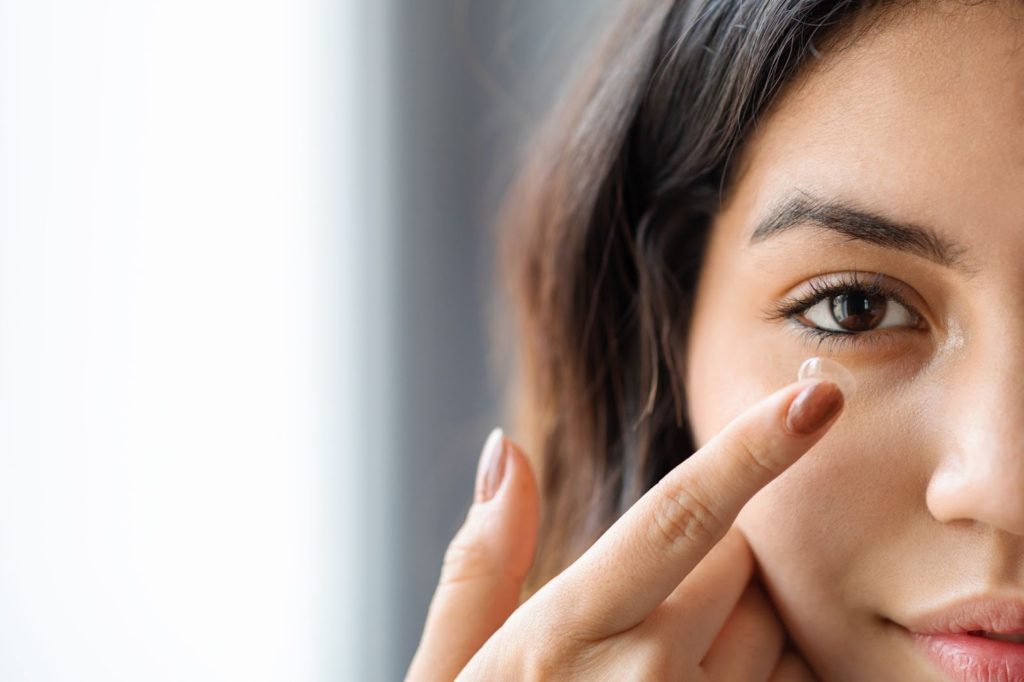For those suffering from dry eye, the irritation and discomfort can become unbearable. Even worse, many people suffering from dry eyes feel as though wearing contact lenses magnifies the dryness. Some people even wonder whether contacts can be worn with dry eyes.
Yes, you can wear contact lenses with dry eyes. To help shed some of the discomfort associated with dry eyes, consider switching to daily lenses, taking breaks from wearing contacts, and using artificial tears that are compatible with contact lenses.
Understanding Dry Eyes
Dry eye disease is a common eye condition that can significantly impact one’s quality of life. This condition affects your tear film, which is responsible for keeping your eyes hydrated. It occurs when the tear film doesn’t produce enough tears, or when the quality of the tears produced is poor.
The tear film consists of 3 layers, and problems with any of these can affect tear production, causing your eyes to feel irritated and uncomfortable.
There are two main types of dry eyes:
- Aqueous Dry Eyes: Occurs when the tear film cannot produce enough tear fluid to keep the eye lubricated and moisturized. Autoimmune disorders are the most common cause.
- Evaporative Dry Eyes: The most common form of dry eyes. Occurs when tears evaporate too quickly from the eye’s surface due to an unstable tear film.
Dry eyes can result in irritated eyes, with additional symptoms that can include:
- Blurry vision
- Burning or stinging sensation
- Frequent blinking
- Light sensitivity
- Redness
- Watery eyes
Various factors can impact the tear film, such as hormonal changes, autoimmune diseases, inflamed eyelid glands, or allergies. Some potential causes of dry eyes include:
- Meibomian Gland Dysfunction (MGD): This is the most common cause of evaporative dry eyes. It occurs when meibomian glands (oil glands along the eyelid) become clogged, reducing secretion of oils that reduce evaporation.
- Environmental Factors: A dry and windy climate, prolonged exposure to screens, and not drinking enough water can increase the risk of tear evaporation.
- Overwearing of Contact Lenses: Wearing contact lenses for extended periods of time reduces oxygen supply to the cornea, and can both disrupt the tear film as well as increase evaporation.
How Does Wearing Contact Lenses Affect Dry Eyes
Wearing contact lenses can exacerbate dry eye symptoms. Contacts sit directly on the eye’s surface, interfering with tear film distribution. This often leads to increased evaporation of natural tears, making your eyes feel even drier.
Potential issues with contact lenses include:
- Reduced Oxygen Supply: Contacts can limit the amount of oxygen reaching your cornea.
- Tear Film Disruption: Lenses can break up the tear film, leading to quicker evaporation.
- Mechanical Irritation: The physical presence of the lens can cause additional irritation.
Fortunately, you can take steps to minimize dry eye symptoms while still wearing contacts. The key is choosing the right type of contact lenses and maintaining a strict eye care routine:
- Use Lubricating Eye Drops: Look for preservative-free artificial tears to keep your eyes moist.
- Switch to Daily Disposables: Daily contacts are better suited for dry eyes because they are thinner and more breathable. Using a fresh lens daily means fewer deposits to cause irritation. It also eliminates the need for cleaning solutions, reducing the risk of contamination and debris.
- Maintain Proper Hygiene: Those wearing reusable extended-wear contacts should clean their lenses thoroughly and follow the replacement schedule to reduce the risk of irritation and infection.
Importance of Taking Breaks
Individuals suffering from dry eyes can still wear contact lenses but should consider taking a break from lenses if their eyes get irritated. Advantages of doing so include:
- Tear Recovery: Removing lenses gives your eyes a chance to recover and rehydrate.
- Reduced Irritation: Frequent breaks can minimize the mechanical irritation caused by lenses.
- Overall Eye Health: Giving your eyes a rest can prevent long-term complications.
Treatment & Prevention of Dry Eyes
Dry eye is a chronic condition. While it can’t be completely treated, symptoms can be managed to provide relief.
Your optometrist plays a crucial role in managing dry eye symptoms. Visiting your optometrist confirms the underlying cause of your dry eyes, recommends the most suitable treatment option based on your ocular needs, and monitors the progress of your treatment plan.
Advanced Dry Eye Therapies
Depending on the severity of your dry eyes, your optometrist may recommend advanced dry eye therapy. These therapies are performed at a clinic, and may provide long-term relief.
- Radiofrequency Therapy: Uses electromagnetic waves to generate heat in order to unclog blocked oil glands responsible for tear production.
- IPL Therapy: Uses different wavelengths of pulsating light to target specific areas of your skin. The resulting heat can soften oils in clogged meibomian glands and help stimulate tear production.
- LipiFlow Treatment: Uses thermal pulsation to treat meibomian gland dysfunction by combining controlled heat with gentle pulsating pressure.
At-Home Therapies
To prevent dry eye irritation exacerbated by contact lens use, there are a few at-home treatment options available:
- Artificial Tears: Uses preservative-free artificial tears to help lubricate the eyes throughout the day (or as needed). Make sure to choose drops that are compatible with contact lenses, so that the drops can permeate through to your eye.
- Humidifier: Dry conditions are a potential cause of dry eyes. Using a humidifier at home can help maintain optimal humidity levels and prevent excessive dryness in the air.
- Limit Screen Time: Minimize screen time whenever possible to help reduce dryness caused by prolonged exposure to digital devices. Implement the 20-20-20 rule to reduce eye strain and irritation.
- Warm Compress: Use a warm compress on your closed eyes and gently massage around the area for a few minutes. This helps unclog oil glands found along the eyelid and helps stimulate tear production.
Schedule an Appointment!
Wearing contact lenses with dry eyes is manageable with proper care and therapies.
For personalized treatment options, connect with our team at Bayside Eye Care to schedule a dry eye therapy consultation.



